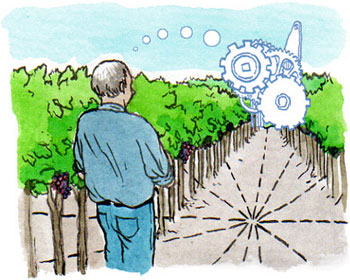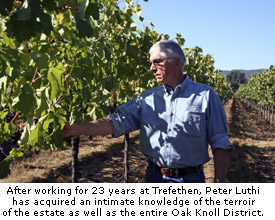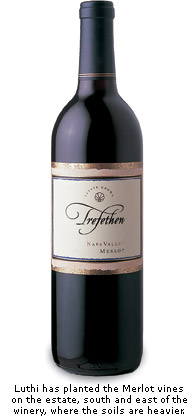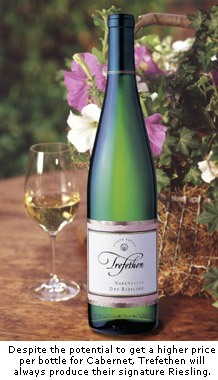

Peter Luthi has the terroir of Trefethen's Estate Vineyard
mapped out with the precision of a Swiss watch.
Oak Knoll District of Napa Valley (AVA)
A Precise and Intimate Knowledge of the Oak Knoll District: An interview with Peter Luthi
by
Alan Goldfarb
November 6, 2006
Alan Goldfarb (AG): You seem to fly under the radar a little bit as a winemaker. When people think of Trefethen Vineyards, they think of John and Janet (the owners). Is that OK with you?
 Peter Luthi (PL): Yes. My satisfaction is not from somebody telling me a compliment or reading about myself someplace, saying how good I’m doing. My satisfaction is from knowing I’ve done the best possible job. Because if I made wine or if I was a chef, it’s just a matter of taste, and I have to realize that I’m making a product that I think is pretty good. Maybe there’s somebody out there that could be doing better than I’m doing. But while I’m doing this job … I constantly tell myself I have to listen to other people.
Peter Luthi (PL): Yes. My satisfaction is not from somebody telling me a compliment or reading about myself someplace, saying how good I’m doing. My satisfaction is from knowing I’ve done the best possible job. Because if I made wine or if I was a chef, it’s just a matter of taste, and I have to realize that I’m making a product that I think is pretty good. Maybe there’s somebody out there that could be doing better than I’m doing. But while I’m doing this job … I constantly tell myself I have to listen to other people.
AG: It’s been said that Oak Knoll is warm enough to ripen Cabernet Sauvignon without being too warm for Chardonnay and Pinot Noir. How can that be?
PL: It can only be if you choose the correct location to plant some of these varietals that take more heat, like Cabernet. When we now replant our vineyard, the most important part is looking at the soil profile and the micro-climate. You’ve got to have all the right conditions. The right terroir has to be there to plant the right varietals.
In our vineyard, we’ve concentrated on planting all the Cabernet in one location north of the winery where there is more gravel and more rock. It’s a lighter, warmer type of soil.
We’ve learned to work with the proper rootstocks. You have to control irrigation. We know that you have to drop crop, you have to do shoot removal and leaf removal. The ratio of vigor to crop has to be controlled very carefully.
It is much more difficult here to properly mature crop levels that are normal in warmer locations of the Napa Valley and still have them mature properly.
 AG: The conventional wisdom now is that Merlot does better in the Carneros and Oak Knoll where it’s cooler than in most of the rest of the valley. Do you concur?
AG: The conventional wisdom now is that Merlot does better in the Carneros and Oak Knoll where it’s cooler than in most of the rest of the valley. Do you concur?
PL: Merlot likes heavier, loamier types of soil. It doesn’t need quite the warmth that Cabernet does. Merlot has a tendency to over-crop if you don’t throttle it back. It’s not unusual to drop half the crop to produce good quality.
AG: So, that would be a yes? Where is your Merlot planted, considering that you don’t want the area to be too warm?
PL: It’s slightly east and south of the winery, which is slightly heavier ground, and not as gravelly.
AG: You’ve worked with the Baldini family in the vineyard for all these years. You recently have begun to work with a new vineyard manager. How different is that for you?
PL: The new director of viticulture is Jon Ruel. I’ve been working with him for the last three years. The Baldinis were typical old farmers. Their strength was in the ability to observe and remember. Most people go through life without smelling the roses, but the Baldinis had a great ability to observe nature and the plants.
I’m pretty easy. I can work with a lot of people. Jon Ruel has a somewhat different, more technical approach to things. Where the Baldinis used to be farming by feeling, Jon Ruel has an understanding of what it takes nowadays, as we move into the 21st century of winemaking. He stays on top of things, realizing that certain things have to be done at certain times and it can’t be delayed. Such as leaf removal, crop thinning, shoot removal.
For me it was a very easy transition. From the point of view of wine and grape quality, it’s also been a very smooth transition. We’ve made some major steps in terms of grape quality.
AG: Such as what?
PL: We went through replanting in 1990. After 15 years, we now know what works and what doesn’t.
 AG: Let’s talk about Riesling. It used to be the most widely planted white grape in the Napa Valley, before Chardonnay caught on in the early ‘80s. Why do you still grow Riesling at Trefethen?
AG: Let’s talk about Riesling. It used to be the most widely planted white grape in the Napa Valley, before Chardonnay caught on in the early ‘80s. Why do you still grow Riesling at Trefethen?
PL: When we were replanting back in the early ‘90s, I still remember the day that we faced this question. We had to ask ourselves if planting Cabernet was perhaps better because we could get a much better bottle price.
Still, we’ve been making Riesling for a long time and made a name for ourselves. I really like Riesling, and it would be boring if we couldn’t make Riesling anymore. We make a wine that we like to drink.
AG: What kind of vineyard is that 20-acre Riesling parcel?
PL: We have two different blocks in two locations. One is in a northern location north of the winery where there’s more gravel (near the Cabernet site). I’ve always liked the characteristics and the amount of intensity of fruit. It’s also very floral.
There’s lot of botrytis most years for our late harvest. We don’t just get rot, but it dries out. We get 10- to 20-percent infection (of botrytis) because of our location and the microclimate. The other block is a little warmer and is east of the winery where we have our best Chardonnay and a little Merlot. It retains good acidity and we can develop citrus characteristics. (The fruit from the two blocks are then blended to produce 5,500 cases a year.)
AG: Do you think Riesling is making a comeback and do you have plans to plant more?
PL: We’ve talked about doing that, but we’re not sure we want to crank that up.
AG: What is in store for the Oak Knoll District?
PL: We’re two years into the new AVA and we’re getting more and more people interested. There are lot of varietals planted and not just Chardonnay and Merlot. As people get more focused on this, I think you’ll see more of an interest in trying to figure out what grows best in what areas.
We’re learning more and more about the region. Instead of just growing grapes, people are looking at the characteristics of the grapes. But no one has defined an Oak Knoll characteristic yet.
AG: What do you think it is?
PL: I think because
 Peter Luthi (PL): Yes. My satisfaction is not from somebody telling me a compliment or reading about myself someplace, saying how good I’m doing. My satisfaction is from knowing I’ve done the best possible job. Because if I made wine or if I was a chef, it’s just a matter of taste, and I have to realize that I’m making a product that I think is pretty good. Maybe there’s somebody out there that could be doing better than I’m doing. But while I’m doing this job … I constantly tell myself I have to listen to other people.
Peter Luthi (PL): Yes. My satisfaction is not from somebody telling me a compliment or reading about myself someplace, saying how good I’m doing. My satisfaction is from knowing I’ve done the best possible job. Because if I made wine or if I was a chef, it’s just a matter of taste, and I have to realize that I’m making a product that I think is pretty good. Maybe there’s somebody out there that could be doing better than I’m doing. But while I’m doing this job … I constantly tell myself I have to listen to other people.AG: It’s been said that Oak Knoll is warm enough to ripen Cabernet Sauvignon without being too warm for Chardonnay and Pinot Noir. How can that be?
PL: It can only be if you choose the correct location to plant some of these varietals that take more heat, like Cabernet. When we now replant our vineyard, the most important part is looking at the soil profile and the micro-climate. You’ve got to have all the right conditions. The right terroir has to be there to plant the right varietals.
In our vineyard, we’ve concentrated on planting all the Cabernet in one location north of the winery where there is more gravel and more rock. It’s a lighter, warmer type of soil.
We’ve learned to work with the proper rootstocks. You have to control irrigation. We know that you have to drop crop, you have to do shoot removal and leaf removal. The ratio of vigor to crop has to be controlled very carefully.
It is much more difficult here to properly mature crop levels that are normal in warmer locations of the Napa Valley and still have them mature properly.
 AG: The conventional wisdom now is that Merlot does better in the Carneros and Oak Knoll where it’s cooler than in most of the rest of the valley. Do you concur?
AG: The conventional wisdom now is that Merlot does better in the Carneros and Oak Knoll where it’s cooler than in most of the rest of the valley. Do you concur?PL: Merlot likes heavier, loamier types of soil. It doesn’t need quite the warmth that Cabernet does. Merlot has a tendency to over-crop if you don’t throttle it back. It’s not unusual to drop half the crop to produce good quality.
AG: So, that would be a yes? Where is your Merlot planted, considering that you don’t want the area to be too warm?
PL: It’s slightly east and south of the winery, which is slightly heavier ground, and not as gravelly.
AG: You’ve worked with the Baldini family in the vineyard for all these years. You recently have begun to work with a new vineyard manager. How different is that for you?
PL: The new director of viticulture is Jon Ruel. I’ve been working with him for the last three years. The Baldinis were typical old farmers. Their strength was in the ability to observe and remember. Most people go through life without smelling the roses, but the Baldinis had a great ability to observe nature and the plants.
I’m pretty easy. I can work with a lot of people. Jon Ruel has a somewhat different, more technical approach to things. Where the Baldinis used to be farming by feeling, Jon Ruel has an understanding of what it takes nowadays, as we move into the 21st century of winemaking. He stays on top of things, realizing that certain things have to be done at certain times and it can’t be delayed. Such as leaf removal, crop thinning, shoot removal.
For me it was a very easy transition. From the point of view of wine and grape quality, it’s also been a very smooth transition. We’ve made some major steps in terms of grape quality.
AG: Such as what?
PL: We went through replanting in 1990. After 15 years, we now know what works and what doesn’t.
 AG: Let’s talk about Riesling. It used to be the most widely planted white grape in the Napa Valley, before Chardonnay caught on in the early ‘80s. Why do you still grow Riesling at Trefethen?
AG: Let’s talk about Riesling. It used to be the most widely planted white grape in the Napa Valley, before Chardonnay caught on in the early ‘80s. Why do you still grow Riesling at Trefethen?PL: When we were replanting back in the early ‘90s, I still remember the day that we faced this question. We had to ask ourselves if planting Cabernet was perhaps better because we could get a much better bottle price.
Still, we’ve been making Riesling for a long time and made a name for ourselves. I really like Riesling, and it would be boring if we couldn’t make Riesling anymore. We make a wine that we like to drink.
AG: What kind of vineyard is that 20-acre Riesling parcel?
PL: We have two different blocks in two locations. One is in a northern location north of the winery where there’s more gravel (near the Cabernet site). I’ve always liked the characteristics and the amount of intensity of fruit. It’s also very floral.
There’s lot of botrytis most years for our late harvest. We don’t just get rot, but it dries out. We get 10- to 20-percent infection (of botrytis) because of our location and the microclimate. The other block is a little warmer and is east of the winery where we have our best Chardonnay and a little Merlot. It retains good acidity and we can develop citrus characteristics. (The fruit from the two blocks are then blended to produce 5,500 cases a year.)
AG: Do you think Riesling is making a comeback and do you have plans to plant more?
PL: We’ve talked about doing that, but we’re not sure we want to crank that up.
AG: What is in store for the Oak Knoll District?
PL: We’re two years into the new AVA and we’re getting more and more people interested. There are lot of varietals planted and not just Chardonnay and Merlot. As people get more focused on this, I think you’ll see more of an interest in trying to figure out what grows best in what areas.
We’re learning more and more about the region. Instead of just growing grapes, people are looking at the characteristics of the grapes. But no one has defined an Oak Knoll characteristic yet.
AG: What do you think it is?
PL: I think because














